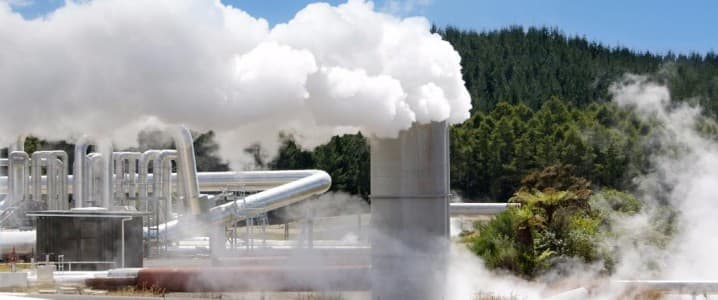In response to Paris Agreement targets and pledges made at the 2021 COP26 climate summit, governments and energy firms around the world are looking to expand their energy portfolios and tap into a wide variety of clean energy sources. Beyond the most well-known – solar and wind – there are a plethora of other renewable energy options being explored to varying degrees of success. One little-talked-about possibility is geothermal energy, the largely untapped power source that exists far underground in superhot rock. A recent report expands upon the significant potential for this type of energy production, adding to existing work in traditional geothermal energy.

Geothermal energy is generated by accessing underground heat pockets by drilling down into the surface of the Earth. The gradual decay of radioactive particles in the earth's core produces geothermal energy. The earth’s core has a temperature of around 5,200°C, meanwhile, rock and water in the Earth’s crust can reach temperatures of around 370°C. Thermal energy can be accessed in the rocks and water just a few miles underground by drilling into underground reservoirs to tap into geothermal sources. The heat can drive turbines for electricity production. Around 16 GW of the world’s energy comes from geothermal operations at present, around 0.2 percent of our total energy usage.
However, superhot rock energy production is slightly different. This is an advanced form of geothermal energy, which requires innovative deep drilling techniques to access heat in the rocks. The development of enhanced geothermal systems (EGS) could countries worldwide access the low-cost renewable energy source with a small land-use footprint. However, it will take significant investment in research and development to advance these types of systems.
An October report, Superhot Rock Energy: A Vision for Firm, Global Zero-Carbon Energy, from the NGO Clean Air Task Force, demonstrates that geothermal energy could be one of the most cost-effective, net-zero carbon power sources, as well as having a very small impact on the environment compared to several alternatives. The organisation commissioned the Hot Rock Energy Research Organization, which specialises in geothermal energy, as well as energy consultancy LucidCatalyst, to estimate the cost of commercial-scale superhot rock geothermal electricity production. The two companies believe this form of energy production would cost around $20 to $35 per megawatt hour, making it competitive with natural gas-based electricity production.
At present, there are no superhot rock geothermal energy systems in operation, although several companies around the world are funding research and development into the energy source. The report suggests that the types of technology required to access superhot rock energy may be commercially available in the 2030s. Clear Air highlighted the lack of funding for geothermal projects, compared to other renewable energy programmes such as nuclear, carbon capture, and hydrogen.
Bruce Hill, the author of the report, explained “Superhot rock geothermal isn’t even in the decarbonization debate — but given a decade or two of aggressive investment it could be producing baseload power — local, energy-dense, clean-firm (baseload) and competitive,” from a price perspective. He highlights the potential for tapping into superhot rock energy, “Conventional geothermal energy is limited to regions where concentrated heat is near-surface, such as volcanoes or areas where the Earth’s crust is thin… With advanced drilling methods, superhot rock energy will unlock the inexhaustible heat that exists everywhere beneath our feet. This heat illuminates a path to terawatts of localized clean firm energy that could power the world’s electric grids, supply residential and industrial heat and produce zero-carbon hydrogen for a secure, equitable energy future.”
Terra Rogers, Program Director, Superhot Rock Energy stated of the clean energy source, “The beauty of superhot rock energy is that it requires no additional scientific breakthroughs. There are dozens of wells across the globe that have reached superhot conditions, and, with the right technical and commercial advances, we could see commercialization in years, not decades.”
A few projects already exist, mainly in the technology development stage, and several more are planned for Japan, Iceland, Italy, Mexico, New Zealand, and the U.S., according to the report. In the U.S., there is significant potential for the development of more complex geothermal operations thanks to support from the Department of Energy (DoE), which announced in September it was aiming to cut the cost of enhanced geothermal systems by 90 percent by 2035. U.S. Secretary of Energy Jennifer M. Granholm highlighted that over five terawatts of heat resources – enough to meet the electricity needs of the entire world – exist in the United States, which could support America’s goal for net-zero emissions by 2050.
Granholm stated, “The United States has a vast, geothermal energy resource lying right beneath our feet, and this program will make it economical to bring that power to American households and businesses.” And “DoE’s Enhanced Geothermal Shot will move geothermal technology from research and development to cost-effective commercial adoption, helping energy communities and workers transition to producing clean energy for the future,” she added.
While several geothermal energy projects already exist worldwide, there is significant potential for the development of enhanced geothermal systems over the next decade. The advancement of these types of systems could provide greater access to low-cost renewable energy with a smaller impact on the environment than many other green alternatives, according to a recent report. With the DoE expected to cut EGS costs over the coming years, experts expect to see greater innovations in the technology required to access superhot rock geothermal energy by the 2030s.
